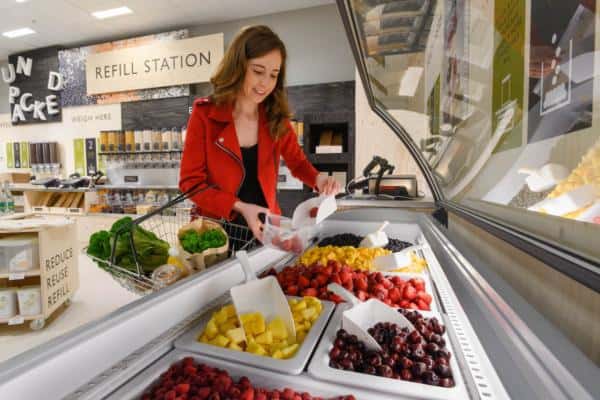Waitrose is expanding packaging-free shopping beyond a dedicated part of its pilot shop into the regular aisles as it looks to gauge how far shopper appetites extend.
The supermarket now offers 51 lines, from essentials such as rice, pasta, cereals and coffee to frozen fruit and washing detergent in its Unpacked format. By taking products into its normal aisles, Waitrose wants to find out whether shoppers might buy them in their everyday shopping trips, rather than as part of a dedicated mission.
Waitrose, ranked Top100 in RXUK Top500 research, first launched its Unpacked range to its Botley Road, Oxford, shop in the summer of 2019. Now it is available in three more, in Wallingford, Abingdon and Cheltenham.
James Bailey, executive director of Waitrose, says: “Waitrose Unpacked requires a fundamental change in shopping behaviour that has been ingrained for years. This next phase will help us to understand if we can make refillable a routine part of customers’ shopping trips that would allow us to roll out Unpacked further in the future.”
The update came as the retailer was ranked first for its efforts to reduce plastics in a new Checking out on plastics III report from Greenpeace and the Environmental Investigation Agency (EIA). That reflects Waitrose’s figures of an absolute plastic reduction of 6.1% since 2017 in its own-brand and branded ranges, as well as its refillable pilot scheme. Waitrose – which came top for the second year in a row – was followed by Aldi, M&S, Lidl, Sainsbury’s and Tesco.
Commenting, Nina Schrank, senior plastics campaigner at Greenpeace UK, says: “Supermarkets have assured their customers that they share their concerns on plastic waste, but we need to see far more ambition than this from the sector if we’re going to even start to turn the tide on plastic pollution.
“All supermarkets should follow Sainsbury’s, and now Aldi, in committing to reduce plastic packaging by 50% by 2025, at the very least. How these commitments are met is also crucial. Half of that reduction should come from reuse and refill systems, so we can ensure that packaging stays in those systems and out of the environment.”
The Waitrose target is to reduce single use plastic by 20% by 2021, and in its own label products by 50% by 2025.
EIA senior campaigner Christina Dixon says: “Supermarket targets and reduction efforts are primarily focused on own-brand plastic packaging, which makes sense as they have more direct control over the supply chain. However, this means that the amount of packaging used for popular branded goods is not reducing and we’d like to see supermarkets increasingly taking the fight to the big manufacturers and compelling them in turn to drive down their own plastic footprints. This can be achieved through sourcing policies that reflect packaging reduction requirements and the phasing out of problematic plastics, working with brands to test alternatives and, ultimately, pledges to de-list suppliers which will not comply.”
What Waitrose has learned so far
A Waitrose report, Unpacked Unpacked, provides an analysis of the original 11-week pilot scheme suggests that by week 10, 45% of Unpacked customers were bringing their own containers – including empty jam jars and ice cream containers – and that 33% took products home without any packaging. Where they didn’t, they would use paper or home compostable Waitrose bags – rather than the reusable boxes that Waitrose supplied for shoppers to borrow. The chief benefits for customers were being able to save money by buying exact quantities or time by not needing to decant products at home.
During the trial, the Unpacked project eliminated 98% of single-use plastic packaging – the equivalent of almost 130,000 pieces of plastic. Total plastic packaging, including reusable items, was down by 83% and total packaging, including glass and card, by 41%. But, the report found, for reusable containers to break even over single use packaging, shoppers need to use them repeatedly. Cotton bags, for instance, need to be used 158 times, Tupperware containers 55 times, and wine bottles six times. Greenhouse gas emissions associated with the number of times a container is used are not significant compared to those generated through food production and food waste, however, according to the report, since a third of all food produced around the world is wasted.
The Unpacked Unpacked report says that for refillable models to work at scale, more efficient solutions need to be found for managing food safety and standards, while investment in automated measuring equipment is important. Clear product information is essential – and washable food labels desirable – while research into the impact of removing packaging would help it understand the overall environmental benefit of refill models. It also says that supermarkets need to develop common approaches to measurement and to publish their packaging reduction strategy and targets.









